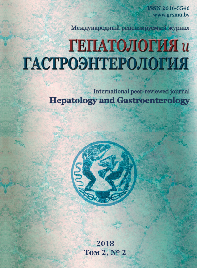ERRORS OF MORPHOLOGICAL DIAGNOSTICS OF LIVER LESIONS
Abstract
Background. Liver biopsy (BP), being the "Golden Standard" for diagnosing various liver diseases, is not without drawbacks, the causes of which depend on subjective and objective factors. The objective of the study is to present possible errors in the morphological examination of the liver and the ways of their elimination.
Materials and methods. The object of the study were liver biopsy specimens obtained with aspiration liver biopsy in patients with chronic diffuse lesions of the liver of various etiologies. The biopsy was performed after receiving written informed consent from the patient in accordance with the necessary conditions. There were no complications during the biopsy. Sets for aspiration liver biopsy were used.
Results. The objective reasons for errors include the limitation of the method due to the probability of obtaining a material that is insignificant in volume. Fragmentation of the biopsy, which occurs in cirrhosis of the liver, does not always make it possible to visualize septa and portal tracts, because in their place in the sections there are original "notches". Purulent hepatitis can mimic a purulent exudate caught in a needle from a liver capsule. Cirrhosis of the liver can simulate thin fibrous cords that dissect from the thickened capsule into the body, dissecting the parenchyma into lobules. In these cases, the portal tracts located near the liver capsule are close together and slightly sclerotized.
Subjective reasons include the following: lack of continuity in the work of the attending physician and morphologist, violation of biopsy sampling in intraoperative biopsy, tactical errors of the morphologist (fixation, wiring, coloring, pouring, slices, evaluation, disturbance of the biopsy study, formulation of the conclusion, etc.). To obtain an objective result, it is necessary to introduce a complex clinico-morphological method into practice, including clinical-laboratory, light-optical, electron microscopic, histochemical, immunohistochemical, molecularbiological (PCR) studies.
Conclusion. The results of the morphological evaluation of liver biopsy depend on the experience and qualifications of the morphologist. Differences in the evaluation of morphological changes concern primarily the index of histological activity, while verification and interpretation of dystrophic, necrotic, inflammatory and sclerotic processes are less susceptible to discrepancies. More than 30 years of personal experience in conducting blind aspiration liver biopsies and morphological diagnostics of liver lesions enables the authors to conclude that the morphological study of the liver biopsy compared to all known diagnostic methods is unprecedented.
References
1. Zakhia K, Etienne D, Asarian A, Reddy M. Gerald Klatskin (1910-1986): A pioneer in hepato-biliary disorders and biopsy techniques. Journal of Medical Biography. 2018;1:967772018778028. doi: 10.1177/0967772018778028.
2. Huang C, Lorentzen T, Skjoldbye B, Rosenberg J, Nolsøe CP. Fast-track, ambulatory ultrasound-guided Tru-Cut liver biopsy is feasible and cost-efficient. Danish Medical Journal. 2015;62(7):A5110.
3. Alten TA, Negm AA, Voigtländer T, Jaeckel E, Lehner F, Brauner C, Wedemeyer H, Manns MP, Lankisch TO. Safety and performance of liver biopsies in liver transplant recipients. Clinical Transplantation. 2014;28(5):585-589. doi: 10.1111/ctr.12352. doi: 10.1111/ctr.12352.
4. Serov VV, Drozd TN, Lebedev SP, Popova IV, Popov MS, Sekamova SM, Beketova TP, Lavadnaja MG; Serov VV, Lapish K. eds; USSR Academy of Medical Sciences. Morfologicheskaja diagnostika zabolevanij pecheni [Morphological diagnosis of liver diseases]. Moscow: Medicina; 1989. 336 p. (Russian).
5. Komarova DV, Tsinzerling VA. Morfologicheskaja diagnostika infekcionnyh porazhenij pecheni [Morphological diagnosis of infectious lesions to the liver]. Saint Petersburg: SOTIS; 1999. 245 p. (Russian).
6. Galambos JT. Cirrhosis. Philadelphia: Saunder; 1979. 376 p.
7. Leuschner U, Leuschner M, Strohm WD, Hübner K, Kurtz W, Hagenmüller F. Laparoscopie und Blindpunktion in der modernen Leberdiagnostik. Leber, Magen, Darm. 1981;11:245-250.
8. Loginov AS, Aruin LI. Klinicheskaja morfologija pecheni. Moscow: Medicina; 1985. 240 p. (Russian).
9. Nepomnyaschih DL, Aydagulova SV, Nepomnyaschih GI; Russian Academy of Medical Sciences. Biopsija pecheni: patomorfogenez hronicheskogo gepatita i tsirroza [Liver biopsy: Pathomorphogenesis of chronic hepatitis and cyrrhosis]. Moscow: Izdatelstvo RAMN; 2006. 368 p. (Russian).


















1.png)






